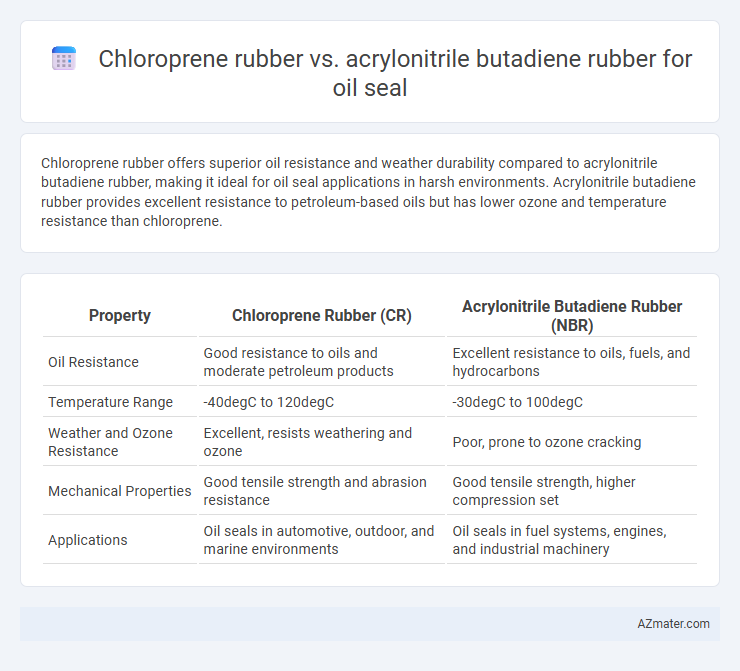Chloroprene rubber offers superior oil resistance and weather durability compared to acrylonitrile butadiene rubber, making it ideal for oil seal applications in harsh environments. Acrylonitrile butadiene rubber provides excellent resistance to petroleum-based oils but has lower ozone and temperature resistance than chloroprene.
Table of Comparison
| Property | Chloroprene Rubber (CR) | Acrylonitrile Butadiene Rubber (NBR) |
|---|---|---|
| Oil Resistance | Good resistance to oils and moderate petroleum products | Excellent resistance to oils, fuels, and hydrocarbons |
| Temperature Range | -40degC to 120degC | -30degC to 100degC |
| Weather and Ozone Resistance | Excellent, resists weathering and ozone | Poor, prone to ozone cracking |
| Mechanical Properties | Good tensile strength and abrasion resistance | Good tensile strength, higher compression set |
| Applications | Oil seals in automotive, outdoor, and marine environments | Oil seals in fuel systems, engines, and industrial machinery |
Introduction to Oil Seals and Essential Materials
Oil seals require materials with strong resistance to oil, heat, and wear to ensure long-lasting performance in preventing lubricant leakage. Chloroprene rubber (CR) offers good resistance to weathering, ozone, and moderate oil exposure, making it suitable for general sealing applications. Acrylonitrile butadiene rubber (NBR), with its superior oil and fuel resistance and excellent mechanical properties, is often preferred for demanding oil seal applications in automotive and industrial machinery.
Overview: Chloroprene Rubber (CR) Properties
Chloroprene Rubber (CR) offers excellent oil resistance, good weathering, ozone, and chemical stability, making it ideal for oil seals used in harsh environments. Its inherent flexibility and strong tensile strength provide reliable sealing performance under dynamic conditions involving oil and grease exposure. Compared to Acrylonitrile Butadiene Rubber (NBR), CR exhibits superior resistance to aging and moderate oil resistance, making it suitable for applications requiring long-term durability and moderate fuel exposure.
Overview: Acrylonitrile Butadiene Rubber (NBR) Properties
Acrylonitrile Butadiene Rubber (NBR) offers excellent resistance to oils, fuels, and chemicals, making it ideal for oil seal applications requiring durability in harsh environments. NBR features a high tensile strength, good abrasion resistance, and varying hardness levels that can be tailored for specific sealing needs. Compared to Chloroprene rubber, NBR excels in oil resistance and temperature stability, ensuring reliable performance in automotive and industrial oil seal systems.
Chemical Resistance: CR vs NBR in Oil Seals
Chloroprene rubber (CR) offers superior chemical resistance to a wide range of oils, fuels, and solvents used in oil seals compared to Acrylonitrile butadiene rubber (NBR). NBR provides excellent resistance to aliphatic hydrocarbons and mineral oils but shows lower performance against aromatic solvents and certain chemicals, where CR excels due to its enhanced polarity and molecular structure. For applications requiring durability in aggressive oil environments, CR is often preferred for oil seals requiring balanced chemical resistance and mechanical properties.
Temperature Tolerance Comparison
Chloroprene rubber (CR) offers a temperature tolerance range of approximately -40degC to 120degC, making it suitable for moderate heat exposure in oil seal applications. Acrylonitrile butadiene rubber (NBR) withstands temperatures from -40degC up to 100degC, but with superior resistance to oil and fuel, it may degrade faster at higher temperatures compared to CR. For oil seals exposed to elevated temperatures above 100degC, Chloroprene rubber provides better thermal stability and durability than NBR.
Mechanical Strength and Elasticity
Chloroprene rubber (CR) exhibits superior mechanical strength compared to acrylonitrile butadiene rubber (NBR), making it highly resistant to wear and tear in oil seal applications. NBR offers excellent elasticity and flexibility, enhancing its sealing performance under dynamic conditions involving oil exposure and temperature variations. The balance of mechanical strength and elasticity in these materials determines their suitability, with CR favored for durability and NBR preferred for flexibility in oil seals.
Compatibility with Lubricants and Oils
Chloroprene rubber (CR) offers excellent compatibility with petroleum-based oils, lubricants, and greases, maintaining flexibility and resistance to swelling, making it suitable for oil seals in automotive and industrial applications. Acrylonitrile butadiene rubber (NBR) excels in resistance to a wide range of oils, fuels, and synthetic lubricants, particularly those with high oil content, providing superior swelling resistance and durability under mechanical stress. NBR's chemical structure specifically enhances its oil resistance compared to CR, making it the preferred choice for seals exposed to aggressive oil-based environments.
Cost and Availability Analysis
Chloroprene rubber (CR) offers moderate cost with good oil resistance, making it a cost-effective choice for oil seals in automotive and industrial applications. Acrylonitrile butadiene rubber (NBR) typically presents lower cost and higher availability due to its widespread production, providing excellent resistance to oils and fuels, which is critical in seal performance. The availability of NBR in various grades and its cost competitiveness often make it the preferred material for oil seals requiring reliable performance in petroleum-based environments.
Industry Applications and Usage Trends
Chloroprene rubber (CR) offers excellent oil resistance and weatherability, making it ideal for oil seals in automotive, aerospace, and industrial machinery applications where moderate exposure to petroleum-based fluids occurs. Acrylonitrile butadiene rubber (NBR) is preferred in oil seals for its superior resistance to a broad range of oils, fuels, and chemicals, particularly in heavy-duty fuel systems, hydraulic equipment, and industrial pumps. Current usage trends favor NBR for high-performance oil seals due to its enhanced chemical resistance and durability, while CR remains popular in applications requiring balanced oil resistance and environmental resilience.
Choosing the Right Rubber for Oil Seal Performance
Chloroprene rubber (CR) and acrylonitrile butadiene rubber (NBR) are both widely used materials for oil seals, with selection primarily based on chemical resistance and temperature tolerance. NBR excels in oil, fuel, and hydrocarbon resistance, making it ideal for applications involving petroleum oils and fuels at temperatures up to 100degC, while CR offers better weather, ozone, and moderate chemical resistance with a temperature range typically between -40degC and 120degC. Choosing the right rubber depends on the specific operating environment, exposure to oils and chemicals, and required durability for effective oil seal performance.

Infographic: Chloroprene rubber vs Acrylonitrile butadiene rubber for Oil seal
 azmater.com
azmater.com